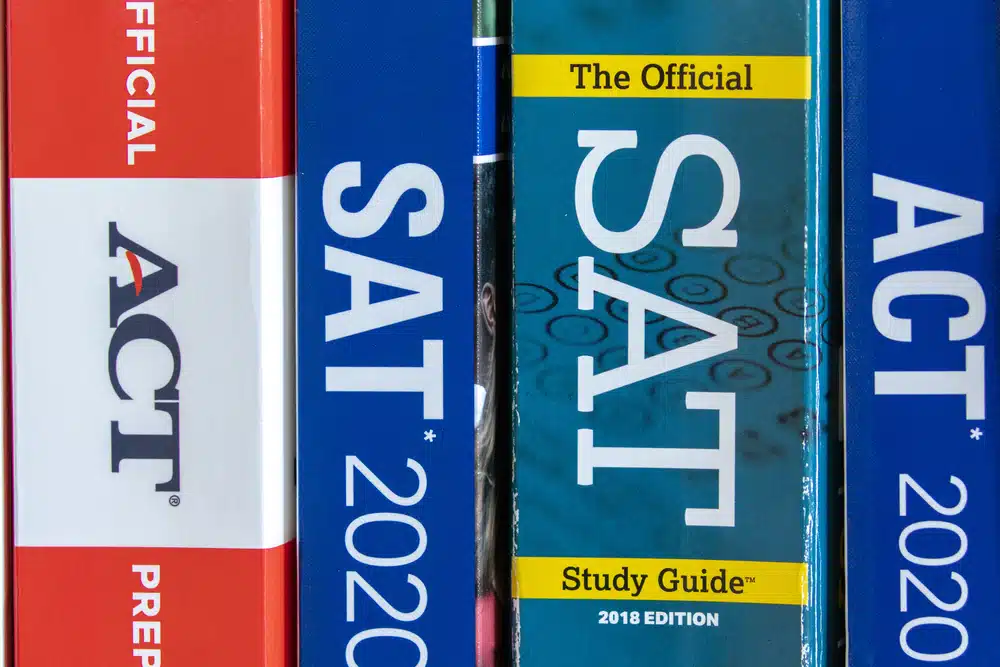SAT Test Dates and Registration Deadlines for 2023-2024
Embarking on the journey to college is a pivotal milestone, and the SAT is a significant step on that path. As an incoming college student navigating through the maze of test preparation, it’s crucial to keep track of the SAT test dates and registration deadlines. These dates are your launchpad to the college of your dreams, and missing them is not an option.
In this comprehensive guide, we’ll walk you through the SAT calendar for the 2023-2024 cycle, ensuring you’re well-prepared to mark those dates on your calendar. Remember, success in the SAT begins with planning — knowing when to register when to prepare, and when to take that all-important test. So grab your planner, and let’s get started on this journey together. You’re not just preparing for a test but setting the stage for your future.
2023-2024 SAT Test Dates and Registration Deadlines
As you gear up for the SAT, one of the first steps is to mark your calendar with the test dates and registration deadlines. For the academic year 2023-2024, the College Board has set specific dates for when you can sit for the SAT, providing multiple opportunities to find a date that fits your schedule.
Here are the SAT test dates and registration deadlines for the 2023-2024 academic year:
2023-2024 SAT Test Dates and Registration Deadline: Fall 2023 Test Dates
| SAT Test Date | Registration Deadline | Deadline for Changes, Regular Cancellation,
and Late Registration |
| Nov 4, 2023 | Oct 5, 2023 | Oct 24, 2023 |
| Dec 2, 2023 | Nov 2, 2023 | Nov 21, 2023 |
2023-2024 SAT Test Dates and Registration Deadline: Fall 2023 Digital SAT Test Dates
| SAT Test Date | Deadline for Registration,
Registration Changes, and Regular Cancellation |
| Nov 4, 2023 | Oct 20, 2023 |
| Dec 2, 2023 | Nov 17, 2023 |
2023-2024 SAT Test Dates and Registration Deadline: March-June 2024 SAT Test Dates
| SAT Test Date | Registration Deadline | Deadline for Changes, Regular Cancellation,
and Late Registration |
| Mar 9, 2024 | Feb 23, 2024 | February 27, 2024 |
| May 4, 2024 | Apr 19, 2024 | April 23, 2024 |
| June 1, 2024 | May 16, 2024 | May 21, 2024 |
2023-2024 SAT Test Dates and Registration Deadline: Anticipated August-December 2024 SAT Test Dates
| SAT Test Date | Registration Deadline | Deadline for Changes, Regular Cancellation,
and Late Registration |
| August 24, 2024 | To be determined | To be determined |
| October 5, 2024 | To be determined | To be determined |
| November 2, 2024 | To be determined | To be determined |
| December 7, 2024 | To be determined | To be determined |
These dates are your key deadlines. Missing a registration deadline means waiting for the next test date, so plan ahead. To register, visit the College Board’s official website and create an account or log in to your existing one. Registration is straightforward: select your test date and center, and if you’re opting for the Essay, include that in your registration too.
Remember, it’s not just about registering. You should also consider the preparation time you’ll need. A good rule of thumb is to start preparing at least three to six months before your chosen test date. This gives you ample time to familiarize yourself with the test format, question types, and to take practice tests.
Late registration is available, but it comes with an additional fee, and there’s no guarantee that you’ll get your preferred test center. So, it’s wise to register early to secure your spot and to avoid any last-minute stress.
Understanding the SAT
Before delving into the specifics of test dates and registration deadlines, it’s important to clearly understand what the SAT is and its role in the college admissions landscape.
What is the SAT?
The SAT is more than just a test; it’s a stepping stone to higher education. Administered by the College Board, the SAT is a standardized test widely used in the United States for college admissions. It’s designed to assess your readiness for college and provide colleges with a common data point that can be used to compare all applicants. But what does the SAT really measure? It evaluates your knowledge and skills in reading, writing, and math — the very foundations that are essential for academic success in college.
Taking the SAT is a ritual that has been part of the American college application process for decades. It consists of two main sections: Evidence-Based Reading and Writing, and Math, with an optional Essay section that some colleges may require. The scores from this test can significantly impact your college application, potentially opening doors to scholarships and even influencing your acceptance to certain programs or universities.
Now, let’s dive into the specifics. The test lasts about three hours, with an additional 50 minutes if you write the essay. It’s a multiple-choice test, scored on a scale of 400 to 1600, combining test results from the two main sections. Remember, the SAT is about showcasing your strengths and how well you can apply your knowledge under pressure. It’s not just a test of what you know; it’s also a test of how you think.
SAT Scoring System
Demystifying how the SAT is scored can give you an edge in your test preparation. Here’s a breakdown of the SAT scoring system that sheds light on what those numbers on your score report mean.
Each of the two main sections of the SAT — Evidence-Based Reading and Writing (EBRW) and Math — is scored on a scale of 200 to 800. These scores are then combined to form your total SAT score, ranging from 400 to 1600. This total score is the sum of your section scores and is often the first thing colleges look at.
But how are these scores calculated? The process starts with your raw score, which is simply the number of questions you answered correctly. There’s no penalty for wrong answers, so it always works in your favor to take a guess, even if you’re unsure.
Your raw score then undergoes a process called equating, which adjusts for slight differences in difficulty between test versions. This ensures that a score from one test date is comparable to a score from another. So, a 600 in EBRW on one test is the same difficulty level as a 600 on a different test.
If you choose to take the optional Essay, it’s scored separately. Two people will read your essay, and each will score it on a scale of 1 to 4 in three different dimensions: Reading, Analysis, and Writing. Their scores are combined, giving you a range of 2 to 8 for each dimension. These scores are reported separately and are not part of your total SAT score.
Understanding the SAT’s scoring rubric can inform your studying strategy. For instance, since there’s no penalty for guessing, you should never leave an answer blank. Knowing how the test is scored helps you approach the SAT with a more effective, strategic mindset, which can ultimately lead to a higher score.
The Digital SAT Test: Embracing the Future of Testing
The SAT test is not left behind as the world shifts towards digital solutions. The Digital SAT Test represents the College Board’s commitment to innovation, aiming to reflect the evolving nature of education and assessment. So, what does this mean for you as a test-taker?
The Digital SAT Test is a computer-based version of the traditional paper-and-pencil SAT. It’s designed to be more relevant to your schoolwork and more straightforward to take. You’ll still be tested on the core areas essential for college success: reading, writing, and math. However, a few key differences set the digital test apart.
Firstly, the Digital SAT is shorter, clocking in at around two hours instead of three. This means less time sitting for the test and more time to focus on each question. The reading passages are shorter, with only one question per passage, allowing you to maintain concentration and showcase your comprehension skills more effectively.
Secondly, the questions are adaptive. The difficulty of the second section of questions will adjust based on your performance in the first section. This allows the test to give a more precise measure of your abilities. Don’t worry about the questions getting tougher as you go — it’s just the test recognizing your potential!
Finally, the scoring for the Digital SAT is the same as the paper SAT, on a scale of 400 to 1600, ensuring that regardless of the format you choose, the scores are comparable and fair. And the best part? Thanks to the digital format, you’ll get your results faster, often in days, not weeks.
The Digital SAT Test is set to roll out globally in 2023 and 2024. This transition reflects the College Board’s dedication to making the SAT more accessible and less stressful while maintaining the high standards that colleges and universities expect.
Understanding the basics of the SAT provides a solid foundation for navigating test dates and registration deadlines, ensuring that students can effectively plan and prepare for their SAT journey.
Why SAT Dates and Deadlines Matter
As students embark on the journey toward college admission, one crucial aspect that demands attention is the scheduling of the SAT. The selection of appropriate test dates and adherence to registration deadlines play a pivotal role in the college application process. Understanding why these dates and deadlines matter can significantly impact a student’s preparation strategy and overall college admission timeline.
How Important is the SAT?
The SAT is really important for college admissions. It’s often the first thing colleges look at to decide who gets in. A good SAT score can also help you get scholarships, which is great because it means less money to pay for college. The test shows colleges that you’re ready for college-level work, so doing well is a sign that you can handle tough classes.
Since every high school grades differently, the SAT gives colleges a fair way to compare students from all over. It also helps you understand which colleges might accept you and which might be too challenging. If other parts of your college application aren’t strong, a high SAT score can help make up for it.
Preparing for the SAT teaches you how to study and manage your time, which are important skills. In the competitive world of college admissions, having a good SAT score can make you stand out from others who have similar grades or activities. And sometimes, even after college, some jobs might ask for your SAT score.
When Can You Take the SAT?
Timing is everything, and this is particularly true when it comes to scheduling your SAT. Choosing an SAT test date isn’t just about marking a day on the calendar. It involves strategic planning. Students need to consider their academic schedule, extracurricular commitments, and preparation time. Selecting an appropriate date ensures that students have ample time to prepare without overloading themselves during academically intensive periods. This balance is key to performing well on the test.
Determining the best time to take the SAT involves careful consideration of several factors:
High School Curriculum: It’s advisable to take the SAT after you’ve completed the core coursework that the test covers, such as algebra, geometry, and critical reading. For most students, this is during the spring of junior year or fall of senior year.
College Application Deadlines: Plan to take the SAT before your college applications are due. Ideally, you should have your scores at least a month before your earliest application deadline.
Preparation Time: Allow yourself enough time to prepare. Aiming for a test date a few months down the line can provide a clear target for your study schedule. Registration deadlines for the SAT are strict. Missing a deadline could mean waiting for the next test date, potentially delaying the entire college application process. Early registration secures a spot and provides the flexibility to choose a convenient test center. Late registrations, while possible, often come with additional fees and limited options.
Personal Schedule: Consider your own schedule and commitments. Avoid dates when you know you’ll be busy with schoolwork, extracurricular activities, or personal commitments.
Multiple Attempts: Many students take the SAT more than once to improve their scores. Consider an initial test during the spring of your junior year. This leaves room to retake the test in the summer or fall of your senior year if you want to improve your score.
Early Decision/Early Action Applicants: If you’re planning to apply early decision or early action, you should aim to take the SAT by the October test date of your senior year at the latest.
SAT Subject Tests: If you’re also interested in taking SAT Subject Tests, you’ll need to plan your schedule accordingly, as you cannot take the SAT and SAT Subject Tests on the same day.
Test Center Availability: Popular test centers can fill up quickly. Registering early can ensure you get a spot at a location that’s convenient for you.
Mental and Physical Readiness: Take the test when you feel mentally and physically ready. If you’re not a morning person, practice waking up early and being alert for a morning exam. Many students opt to take the SAT more than once to improve their scores. Understanding test dates and registration deadlines is crucial for planning retakes. Adequate spacing between test dates allows for review and improvement based on previous performance.
The best time to take the SAT is when you feel prepared and can perform at your best. This might differ for each student, but junior spring or senior fall are generally the most common times.
In essence, the careful selection of SAT test dates and adherence to registration deadlines are not just administrative tasks; they are strategic decisions that can have a lasting impact on a student’s journey to college.
By understanding and respecting these dates, students can optimize their preparation, align with college application timelines, and ultimately enhance their chances of admission to their preferred colleges. And remember, you don’t have to go at it alone; guidance counselors, teachers, and SAT prep tutors can offer invaluable advice tailored to your individual circumstances.
Fees and Cost Considerations
When planning to take the SAT, understanding the associated fees and costs is crucial. These expenses go beyond the basic registration fee and can impact your overall budgeting for the college application process.
When Should You Register for the SAT?
Choosing when to register for the SAT is a critical decision in your college prep timeline. Here’s how you can approach this step with foresight and precision:
- Early Registration: Aim to register for the SAT at least one month before the registration deadline. This secures your spot and gives you peace of mind, allowing you to focus on preparation.
- Account for Preparation Time: Before you register, ensure you have enough time to prepare. A good rule of thumb is to begin studying at least three to six months before your test date.
- Before Junior Year Ends: If you’re a junior, consider registering for an SAT test date in the spring. This can be an optimal time as you’re still in academic mode, and it leaves room for a retake during the fall of your senior year if necessary.
- Consider School and Activity Schedules: Look at your academic and extracurricular calendar. Avoid registering for an SAT date that clashes with major events or commitments that could hinder your study time or performance.
- Test Center Availability: Popular test centers fill up quickly. Register early to get a seat at your preferred location and to avoid the added stress of a long commute on test day.
- Late Registration: A late registration period is available, but it comes with additional fees. It’s best used as a last resort, as your preferred test center may no longer have available seats.
- Special Accommodations: If you need special accommodations for the SAT due to a disability, start the registration process even earlier, as approval from the College Board can take up to seven weeks.
- Fall of Senior Year: If you’re a senior and haven’t taken the SAT yet, register for the earliest fall date available to ensure your scores are ready for college applications.
Planning your registration carefully and giving yourself ample time to prepare allows you to set the stage for a calmer, more controlled test-taking experience. Remember, the SAT isn’t just a test—it’s a milestone in your educational journey, and how you approach it can make all the difference.
Overview of SAT Fees
The primary cost associated with the SAT is the registration fee. The $60 fee covers the cost of taking the test, sending scores to colleges, and providing access to various resources the College Board offers. The fee structure may vary slightly each year and can also differ based on the inclusion of the optional Essay section.
Additional Costs
Several additional costs can arise during the SAT registration and preparation process:
Additional Registration Fees
| Service | Fee | Details |
| Change test center | $25 | For changing your test center only. (To change the test date, you must cancel and register for a new test.) |
| Cancel fee | $25 | For canceling your registration by the change deadline.
Free with fee waiver (upon cancellation, your unused fee waiver benefits will be returned to you). |
| Late cancel fee | $35 | For canceling your registration after the change deadline, by Thursday 11:59 p.m. ET before test day.
Free with fee waiver (upon cancellation, your unused fee waiver benefits will be returned to you). |
| Late registration | $30 | For registering after the regular deadline but before the late registration deadline.
Free with fee waiver. |
Score Service Fees
| Service | Fee | Details |
| Additional score reports | $14 per report
Unlimited free score reports with fee waiver |
The first four score reports are free if you order them by nine days after the test date. Additional reports or reports ordered after that time incur this fee. |
| Rush reports | $31 | Additional score report fees apply. |
| Scores by phone | $15 per call | Available at the same time as online scores. You must pay by credit card at the time of the call. |
| Archived scores | $31 | Additional score report fees apply. |
| SAT Question-and-Answer Service | $16 | Fee waiver available |
| SAT Student Answer Service | $16 | Free with fee waiver |
| Hand score verification | $55 | Fee reduction available |
Fee Waivers and Financial Assistance
Recognizing that the costs associated with the SAT can be a barrier for some students, the College Board offers fee waivers for eligible students. These waivers cover the full cost of the SAT, including the optional Essay, and can also cover the costs of sending additional score reports.
To be eligible for a fee waiver, students typically need to meet certain criteria related to family income or participation in programs like the National School Lunch Program.
Understanding the various fees and costs associated with the SAT and the availability of fee waivers and financial assistance is essential for effective planning and budgeting as part of the college application process.
Where Can You Take the SAT?
Knowing where you can take the SAT is as important as knowing when to take it. The SAT is offered at a variety of locations worldwide, ensuring accessibility for students in different regions.
Domestic and International Test Centers
In the United States, SAT test centers are typically located in high schools and some colleges. Each state has multiple test centers, allowing students to choose a location convenient for them. The SAT is administered internationally in numerous countries at American international schools, universities, and other educational institutions. The College Board’s website provides a searchable database of test centers, enabling students to find the nearest or most convenient location for them.
Special Arrangements for International Students
International students may need to plan well in advance due to limited test centers in some countries. Additionally, it’s important to be aware of any specific requirements or documentation needed for international testing, which may differ from domestic testing policies.
Selecting the Right Test Center
When selecting a test center, consider factors such as distance, accessibility, and familiarity. A center closer to home may reduce travel stress on the test day. Some students prefer taking the test in a familiar environment, like their own school, if it’s an option.
Accommodations and Accessibility
The College Board provides accommodations for students with disabilities at all test centers, ensuring that the SAT is accessible to all students. These accommodations must be approved in advance, so it’s important to plan ahead and make any necessary arrangements.
Digital SAT
With the introduction of the Digital SAT, you may also have the option to take the test at a test center that offers the digital format.
Selecting the right test center is about more than just location; it’s about where you’ll feel most at ease to perform your best. Once you’ve registered, make sure to visit the test center beforehand, if possible. Knowing exactly where you’re going can help reduce anxiety on test day.
When Do SAT Scores Come Out?
After the hard work of preparing and the focus required on test day, it’s natural to wonder when you’ll receive the results of your efforts. One of the most anticipated moments for students after taking the SAT is the release of their scores. Understanding when and how SAT scores are released helps students and families plan for the next steps in their college application process.
Typical Timeline for Score Release
SAT scores are typically released within two to three weeks after the test date. For example, if you take the SAT in a March session, you can expect your scores by late March or early April. This timeline can vary slightly, so it’s important to check the specific dates for your test session on the College Board’s website.
Accessing Your Scores
Students can access their scores online through their College Board account. The College Board notifies students via email when their scores are available. It’s important to ensure that your account’s contact information is up to date to receive these notifications promptly.
Understanding the Score Report
The score report provides detailed information, including your total score, section scores (Evidence-Based Reading and Writing, Math), subscores, and percentiles. This comprehensive breakdown helps in evaluating areas of strength and those needing improvement, especially if considering a retake.
Sending Scores to Colleges
When your scores are available, you can also send them to colleges. You have the option to choose which scores to send if you’ve taken the SAT multiple times, thanks to the College Board’s Score Choice policy. However, some colleges require you to send all your scores.
Delays in Score Release
In some cases, there might be a delay in score release. This could be due to a variety of reasons, like testing irregularities or administrative issues. The College Board provides updates on such situations through its website and direct communication to affected students.
SAT scores are typically released within a few weeks of the test date, and understanding this timeline is crucial for the timely planning of your college applications and any potential retakes.
Remember, while getting your SAT scores is an important step, it’s not the end of the road. Whether your scores are what you expected or not, they’re a starting point for planning your next move — be it celebrating your achievements, planning for a retake, or refining your college application list.
Why Should You Take the SAT?
The SAT is more than just another academic hurdle; it’s a valuable opportunity to stand out in the college admissions process. Here’s why taking the SAT is a step worth considering:
- College Admissions: The SAT is a key component of college applications for many universities. A strong SAT score can enhance your application and demonstrate college readiness.
- Merit-Based Scholarships: Beyond college admissions, a high SAT score can qualify you for scholarships. Many scholarship programs use SAT scores as part of their criteria for awarding financial aid.
- Comparative Tool: With different grading standards across high schools, the SAT provides colleges with a standardized measure to compare all applicants fairly.
- Highlight Your Strengths: The SAT can showcase your strengths in areas your grades might not fully reflect, particularly if you excel in critical thinking and problem-solving.
- Gap Year and Transfer Students: For those taking a gap year or looking to transfer, the SAT scores can remain valid and be a compelling part of your application when you decide to apply or reapply to college.
- Opportunity for Improvement: Unlike many other parts of your college application, like GPA, you can retake the SAT if you’re not satisfied with your scores, providing a chance to improve.
- Career Readiness: The skills assessed by the SAT — critical reading, math, and writing — are relevant to most careers. Preparing for and taking the SAT can help you develop these essential skills.
- Confidence Builder: Preparing for and succeeding on the SAT can boost your confidence. It’s a challenge, but overcoming this hurdle can make you more confident in your academic abilities.
- Global Recognition: For international students, the SAT is a way to demonstrate academic ability and readiness for college-level coursework in the United States.
In essence, the SAT opens doors. It’s an investment in your educational future, and proper preparation can be a pivotal part of your journey to higher education and beyond.
Final Thoughts
As we conclude this guide on SAT test dates and registration deadlines for 2023-2024, remember that the journey to college is a marathon, not a sprint. Staying informed and proactive about SAT scheduling is critical in this journey. Keep track of important dates and deadlines, and plan your preparation accordingly. This approach not only maximizes your chances of achieving your desired score but also helps in maintaining a balanced and stress-free preparation period. With diligence and strategic planning, the SAT can become a manageable and even rewarding part of your college admissions journey. Good luck!
If you’re set on getting into a world-class college but aren’t sure how to make it happen, we can help! AdmissionSight is a leading college entrance expert with over a decade of experience helping students just like you get into the schools of their dreams.
At AdmissionSight, we focus on offering a wide range of services, including helping you become familiar with standardized tests, all aimed at helping you perfect your applications to catch the attention of admissions officers. Contact us today to schedule a free consultation and learn more about what we offer.











































